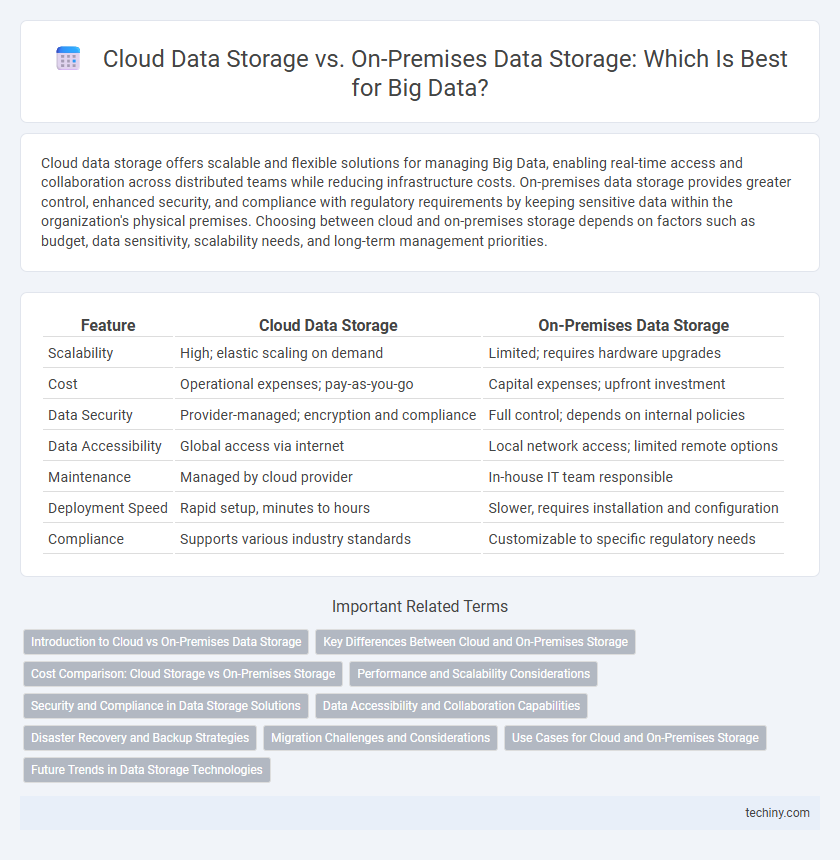Cloud data storage offers scalable and flexible solutions for managing Big Data, enabling real-time access and collaboration across distributed teams while reducing infrastructure costs. On-premises data storage provides greater control, enhanced security, and compliance with regulatory requirements by keeping sensitive data within the organization's physical premises. Choosing between cloud and on-premises storage depends on factors such as budget, data sensitivity, scalability needs, and long-term management priorities.
Table of Comparison
| Feature | Cloud Data Storage | On-Premises Data Storage |
|---|---|---|
| Scalability | High; elastic scaling on demand | Limited; requires hardware upgrades |
| Cost | Operational expenses; pay-as-you-go | Capital expenses; upfront investment |
| Data Security | Provider-managed; encryption and compliance | Full control; depends on internal policies |
| Data Accessibility | Global access via internet | Local network access; limited remote options |
| Maintenance | Managed by cloud provider | In-house IT team responsible |
| Deployment Speed | Rapid setup, minutes to hours | Slower, requires installation and configuration |
| Compliance | Supports various industry standards | Customizable to specific regulatory needs |
Introduction to Cloud vs On-Premises Data Storage
Cloud data storage leverages remote servers hosted on the internet to store, manage, and process data, offering scalability and flexible access. On-premises data storage relies on local physical servers and infrastructure controlled internally, providing greater control and security but limited by capacity and maintenance requirements. The choice between cloud and on-premises solutions depends on factors like cost, compliance, data sensitivity, and organizational needs.
Key Differences Between Cloud and On-Premises Storage
Cloud data storage offers scalable, cost-effective solutions with flexible access and automatic maintenance, ideal for dynamic big data environments. On-premises storage provides greater control, enhanced security, and compliance benefits by keeping data physically within an organization's infrastructure. Key differences include deployment speed, upfront investment, and ongoing management responsibilities, impacting performance, data governance, and operational agility.
Cost Comparison: Cloud Storage vs On-Premises Storage
Cloud data storage typically offers lower upfront costs and scalable pricing models, reducing capital expenditures compared to on-premises data storage, which requires significant initial investment in hardware and infrastructure. Operational expenses for cloud storage include ongoing subscription fees that fluctuate with usage, while on-premises solutions incur consistent maintenance and staffing costs. Over time, cloud storage can provide cost efficiency for businesses handling variable data volumes, whereas on-premises storage may be more cost-effective for organizations with stable, predictable data requirements.
Performance and Scalability Considerations
Cloud data storage offers dynamic scalability and elastic resource allocation, enabling seamless handling of variable workloads with minimal latency impact. On-premises data storage provides predictable performance through dedicated infrastructure but may face limitations when scaling rapidly or accommodating unpredictable spikes in data volume. Evaluating workload patterns and future growth projections is essential to optimize performance and scalability in big data environments.
Security and Compliance in Data Storage Solutions
Cloud data storage offers scalable security features like advanced encryption, regular audits, and compliance with international standards such as GDPR, HIPAA, and SOC 2, making it suitable for dynamic regulatory environments. On-premises data storage provides direct control over physical and network security, allowing organizations to implement customized compliance measures tailored to specific industry regulations. Both solutions require comprehensive risk management strategies, but cloud storage benefits from continuous updates and vendor-managed security, whereas on-premises demands dedicated internal resources for maintaining compliance.
Data Accessibility and Collaboration Capabilities
Cloud data storage offers unparalleled data accessibility by enabling users to access information anytime and anywhere via internet-connected devices, fostering seamless collaboration across geographically dispersed teams. On-premises data storage typically limits access to internal networks or VPNs, which can restrict real-time collaboration and slow decision-making processes. Enhanced integration with cloud-based collaboration tools like Microsoft 365 or Google Workspace further boosts productivity, positioning cloud storage as the optimal solution for dynamic, collaborative big data environments.
Disaster Recovery and Backup Strategies
Cloud data storage offers scalable and automated disaster recovery solutions with frequent, off-site backups that ensure minimal downtime and rapid data restoration. On-premises data storage requires robust local backup infrastructures and manual recovery processes, which can increase recovery time and risk of data loss during catastrophic events. Integrating cloud-based disaster recovery services with on-premises systems enhances backup reliability and accelerates business continuity efforts in the event of hardware failures or cyberattacks.
Migration Challenges and Considerations
Migrating from on-premises data storage to cloud data storage presents challenges such as data transfer speed limitations, potential downtime, and compatibility with existing IT infrastructure. Ensuring data security and compliance during migration requires robust encryption methods and thorough auditing to protect sensitive Big Data assets. Careful assessment of scalability needs, cost implications, and integration with cloud service providers like AWS, Azure, or Google Cloud is essential to optimize the migration strategy.
Use Cases for Cloud and On-Premises Storage
Cloud data storage excels in scalability and remote accessibility, making it ideal for big data analytics, dynamic workloads, and global collaboration. On-premises data storage offers enhanced control, security, and compliance, fitting use cases such as sensitive financial data management, government records, and industries with strict regulatory requirements. Enterprises often combine both approaches in hybrid architectures to optimize performance, cost, and data governance.
Future Trends in Data Storage Technologies
Cloud data storage is rapidly evolving with innovations like edge computing integration, automated data management, and AI-driven analytics, driving scalability and real-time processing capabilities. On-premises data storage continues to advance through enhanced security protocols, hybrid cloud adoption, and high-performance hardware improvements to meet compliance and latency requirements. Emerging trends emphasize hybrid architectures combining cloud flexibility with on-premises control, ensuring optimized data sovereignty, cost-efficiency, and future-proof infrastructure.
Cloud Data Storage vs On-Premises Data Storage Infographic

 techiny.com
techiny.com